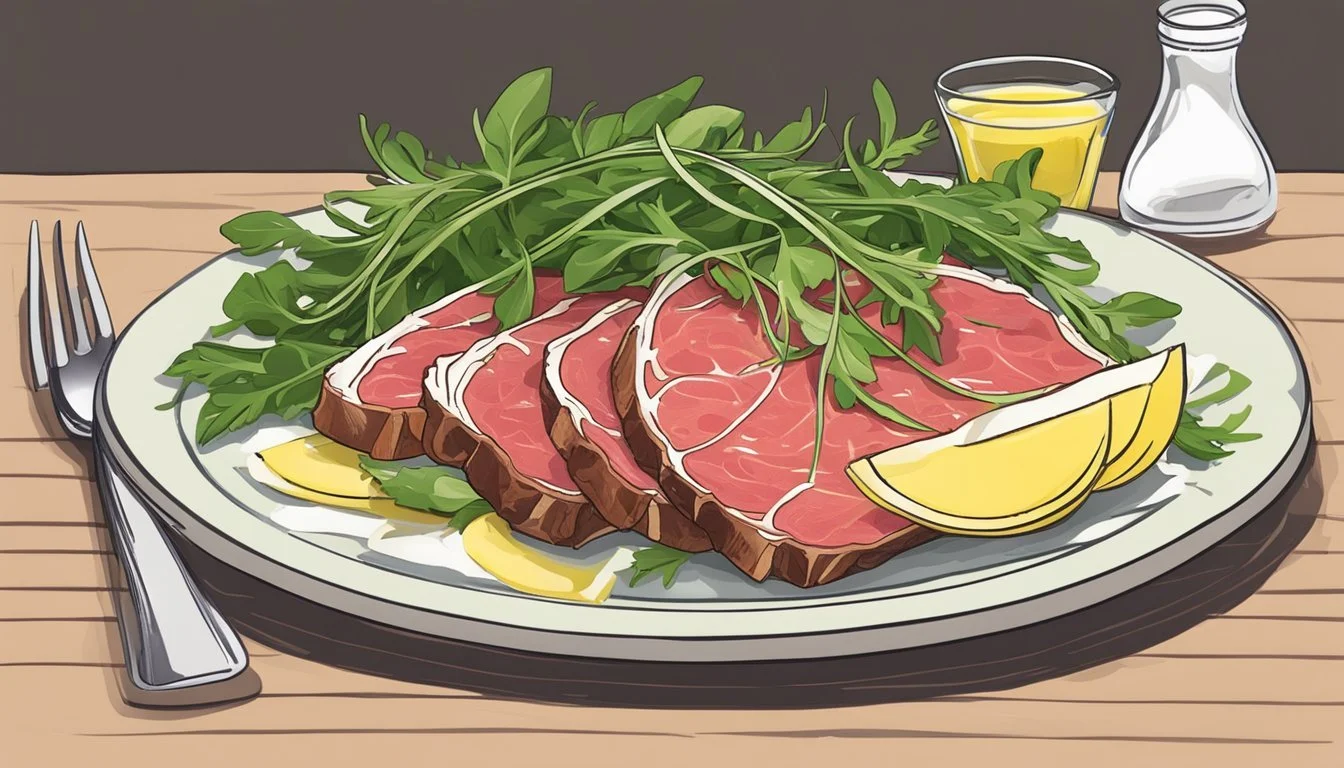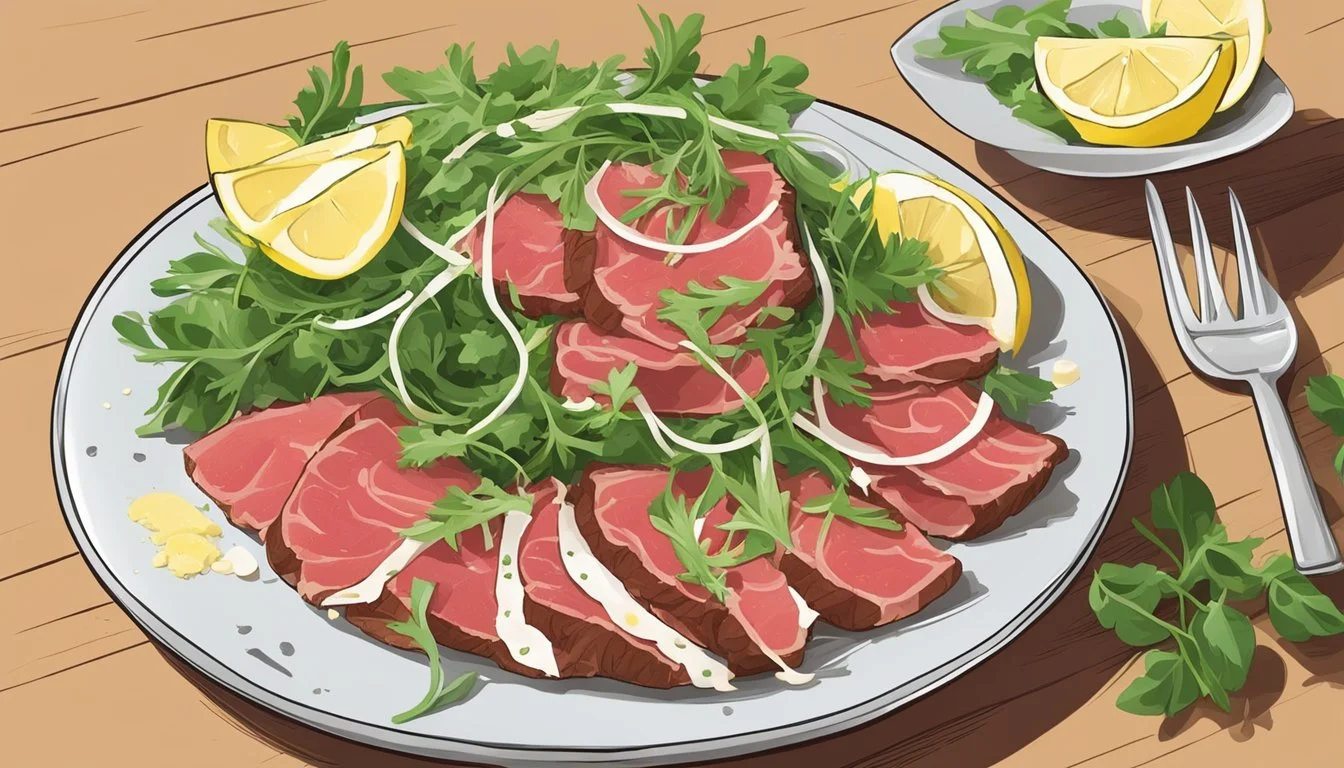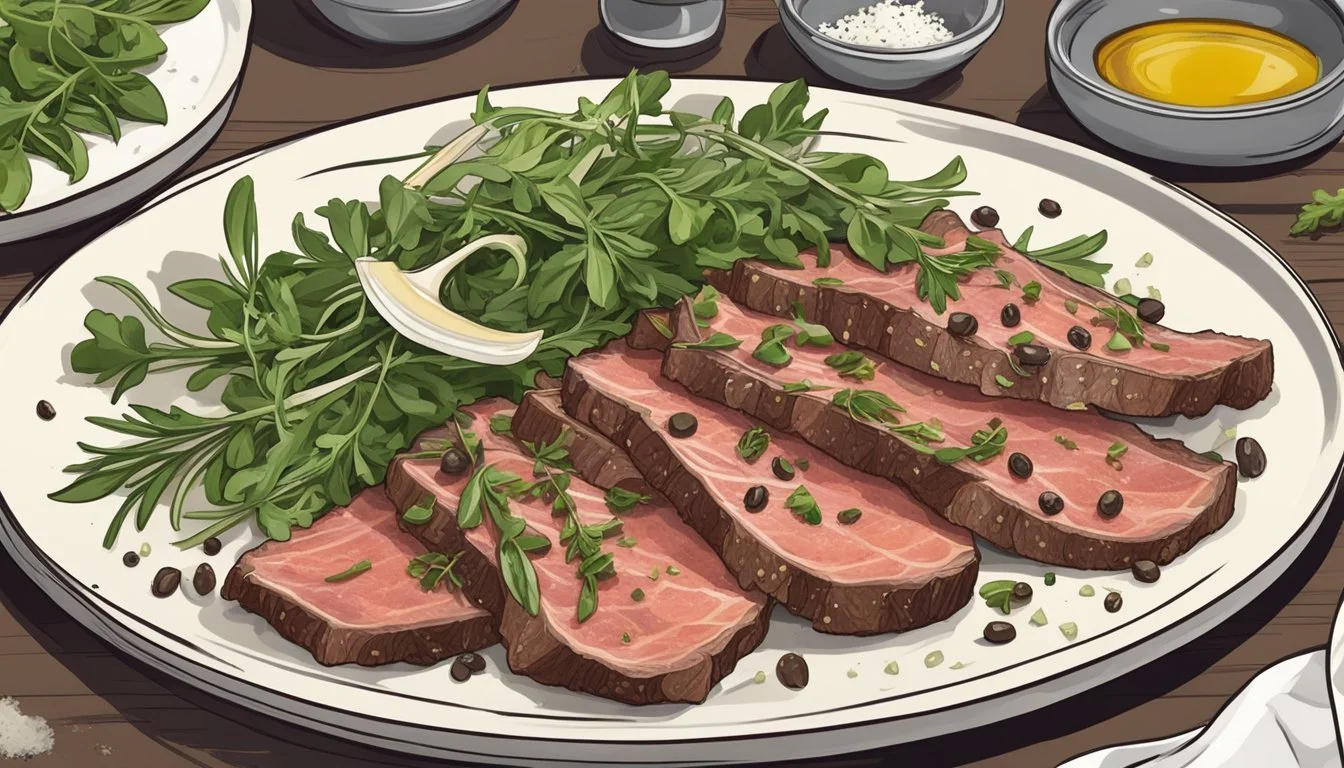How do you eat a beef carpaccio?
Expert Tips for Enjoying This Delicate Dish
Beef carpaccio (What wine goes well with beef carpaccio?) is an Italian appetizer renowned for its simplicity and elegance. Originating from Harry’s Bar in Venice, the dish was conceived by Giuseppe Cipriani in honor of the Venetian painter Vittore Carpaccio. Named after the artist, who was known for his use of red in his paintings, the appetizer reflects a similar hue thanks to the use of raw beef. Traditionally, it is made with thinly sliced beef, such as sirloin or tenderloin, which is served raw and garnished with various accompaniments.
Eating beef carpaccio is an experience that highlights the quality of the meat and the harmony of its accompaniments. It is typically drizzled with olive oil and lemon juice, a combination that brings out the natural flavors of the beef without overwhelming it. Capers, (What wine goes well with capers?) onions, and sometimes Parmesan cheese are also common garnishes that provide texture and complementary flavors. It's a dish that embodies the essence of Italian cuisine, where the freshness and quality of ingredients are paramount.
The creation of the dish was inspired by the request of Countess Amalia Nani Mocenigo when she was advised by her doctors to avoid cooked meats. The beef is prepared by slicing it paper-thin, a technique that ensures it practically melts in the mouth. The dish is a celebration of purity in flavors and textures, designed to be savored with each bite, allowing diners to appreciate the tender quality of the meat and the subtle balance of the seasonings.
Essential Ingredients
Creating the perfect beef carpaccio requires careful selection of high-quality beef and complementary accompaniments and dressings that enhance the natural flavors of the meat. This section details the crucial elements you'll need to assemble this classic dish.
Beef Selection
When selecting beef for carpaccio, it is imperative to choose the highest quality, preferably from a reputable butcher. While various cuts of beef can be used, the most commonly recommended are:
Beef Tenderloin (ideal for its tenderness and minimal connective tissue)
Beef Sirloin (a leaner option that still offers considerable tenderness)
The beef should be sliced thinly to ensure it can be eaten easily in its raw state. Freezing the meat slightly will assist in achieving the desired thinness without difficulty. Typically, the nutritional content per serving can include significant amounts of protein, with varying levels of calories, carbs, fat, and minimal sugars.
Accompaniments and Dressings
A traditional beef carpaccio is not complete without its accompaniments and dressings, which bring out the nuanced flavors of the raw beef. Essentials include:
Arugula (Rocket): Adds a peppery bite and freshness to the dish.
Capers: Small but impactful, offering a burst of salty, vinegary flavor.
Olive Oil: A drizzle of high-quality extra virgin olive oil is key for richness.
Lemon Juice: Provides a much-needed bright acidity.
Parmesan Cheese (Parmigiano-Reggiano): Shave over the top for umami and nutty tones.
Salt and Pepper: Use quality sea salt and freshly ground black pepper for seasoning.
Combine these ingredients delicately to create a well-rounded flavor profile that complements the beef without overpowering it. Optional items like vinaigrette, mustard, or herbs such as thyme and fennel (how long does fennel last?) can add additional layers of taste if used sparingly.
Preparation Techniques
Mastering these preparation techniques is crucial for creating an exemplary beef carpaccio, with attention to the beef's texture and the dish's appearance.
Slicing the Beef
To achieve thinly sliced raw beef, one must first partially freeze the beef tenderloin (What wine goes well with beef tenderloin?) to provide the firmness necessary for thin slicing. Typically, the tenderloin should be in the freezer for approximately 1-2 hours—firm, yet not fully solid. The slicer then employs a sharp knife to cut the beef against the grain into wafer-thin slices, a critical step for a tender bite. Plastic wrap can be used both underneath and on top of the slices if one opts to further thin the meat using a meat mallet or the back of a pan.
Assembling the Dish
After the beef is thinly sliced, it's time to assemble the carpaccio as an appetizer. The slices are carefully transferred to a chilled plate to maintain their firmness. It should then be topped with a salad comprising greens like baby arugula leaves, along with additional fresh ingredients such as olives, (What wine goes well with olives?) nuts, fruit, and vegetables like tomatoes, creating a simple yet sophisticated flavor profile. After assembling, the dish is typically seasoned and can be refrigerated briefly before serving to ensure every bite is refreshing and delectable.
Safe Consumption Practices
Consuming beef carpaccio involves eating raw meat, which requires adherence to strict guidelines to minimize risks of foodborne illnesses.
Understanding Raw Meat Risks
Raw meat can host harmful bacteria, such as Salmonella and E. coli, which can lead to foodborne illnesses. Pregnant women, children, and those with weakened immune systems should be particularly cautious and may choose to avoid raw meat dishes. The Academy of Nutrition and Dietetics advises that consuming cooked meat is generally safer, as proper cooking can eliminate most pathogens.
Preventing Contamination
To minimize risks when preparing beef carpaccio:
Hygiene: Wash hands, surfaces, and equipment thoroughly before and after handling raw meat to avoid cross-contamination.
Refrigeration: Keep the meat refrigerated at a safe temperature until ready to prepare. The recipe should be followed promptly to ensure freshness.
Selecting Meat: Choose high-quality, fresh beef preferably sourced from a trustworthy supplier known for safe handling practices.
Safe to Eat: Some chefs use a technique to sear the meat briefly on the outside, which can kill bacteria on the surface. However, the interior remains raw.
Serving: Serve beef carpaccio immediately after preparing as delaying increases the risk of bacterial growth.
Recipe Variations
Beef carpaccio is a traditional Italian dish that can be adapted in several ways to suit different dietary preferences and cultural tastes. Here are some creative variations that reimagine this classic appetizer.
Fish and Vegetarian Alternatives
Salmon: Substitute thinly-sliced, high-quality salmon for beef to create a carpaccio that is rich in omega-3 fatty acids. Pair with a lemon vinaigrette to complement the fish's natural flavors.
Tuna: Opt for fresh, sushi-grade tuna. Its meaty texture makes for an excellent sea-sourced alternative to traditional beef carpaccio.
Vegetarian Carpaccio:
Vegan Options: For a completely plant-based variant, use thin slices of zucchini or beetroot. Dress with a mustard and egg-free vinaigrette to maintain the classic carpaccio experience without the meat.
Vegetarian Twists: Replace the beef with thinly-sliced rounds of ripe tomatoes or pear. Sprinkle with capers and curls of Parmesan for a refreshing and light dish.
International Twists
Italian: Incorporate antipasto elements like olives or artichoke hearts for a deeper dive into Italian flavors.
Steak Tartare Influence: Drawing inspiration from the French steak tartare, consider adding a raw egg yolk on top of the thinly sliced beef, creating a rich and creamy dressing as it mixes with the other ingredients.
Bellini Pairing: Serve your carpaccio variation with a Bellini, a popular Italian cocktail, to provide a sweet counterbalance to the savory dish.
Garnish and Presentation Ideas
Mustard: Enhance the flavor profile with a dash of mustard in the dressing or dotted around the plate for a bit of heat.
Capers and Parmesan: An arrangement of salty capers and Parmesan cheese adds not only a burst of flavor but also textural contrast to the velvety slices of meat or alternative base.
Instagram-Ready Presentation: To make the dish visually appealing for social sharing, focus on creating a plate with bright colors and use garnishes strategically for an artful presentation.
GitHub Flavored Markdown does not support tables.
Nutritional Information
Beef carpaccio is a dish often praised for its rich flavor and delicate texture. When it comes to its nutritional content, understanding the key components is crucial for those monitoring their dietary intake. Typically, a serving of beef carpaccio has around 180-181 calories per serving size, which generally refers to an amount of approximately 3 oz cooked (113 g).
Fat plays a significant role in the caloric composition of the dish, with totals around 13 grams per serving. This includes various types of fats:
Saturated Fat: 5.9g (approximately 30% of daily value)
Trans Fat: 0.1g
Polyunsaturated Fat: 1.1g
Monounsaturated Fat: 5.8g
The fat content contributes to approximately 40% of the calorie makeup in a serving of beef carpaccio. The presence of saturated and trans fats points toward a need for moderation, as they can impact cardiovascular health.
In terms of protein, beef carpaccio is a good source, providing a boost for muscle maintenance and growth. The exact protein content can vary but is generally substantial given the dish's beef component.
Carbohydrates are typically minimal in beef carpaccio since it mainly consists of thinly sliced beef, unless it's served with bread or other carb-containing accompaniments. Sugars are also low to non-existent, as the dish does not usually include sweeteners.
The dish also offers essential nutrients found in beef, such as iron and certain B vitamins, which are important for energy and metabolism. However, the specific nutrient profile can vary depending on the cut of beef and preparation style.
For individuals who watch their dietary intake carefully, beef carpaccio can be incorporated into a balanced meal, paying close attention to portion sizes and the types of fat consumed.
Pairings and Serving Suggestions
Beef carpaccio is traditionally served as a starter with a variety of pairings that complement its delicate flavor.
Wine: A glass of red wine makes an excellent companion to beef carpaccio. The tannins in red wines such as Cabernet Sauvignon or Merlot balance the savory notes of the meat, while lighter varieties like Pinot Noir match the dish's subtleness.
Cabernet Sauvignon: Robust, with dark fruit and leather notes.
Merlot: Softer tannins, with berry and plum flavors.
Pinot Noir: Light-bodied, with cherry and earthy undertones.
Cocktail: Those opting for a cocktail might consider a light aperitif such as an Aperol Spritz or a classic Martini. These choices cleanse the palate and enhance the carpaccio's flavors.
Aperol Spritz: Bitter-sweet, refreshing with a citrus kick.
Martini: Dry, with a botanical edge from the gin and vermouth.
Side Dishes: To accompany beef carpaccio, side dishes should be light and refreshing.
Arugula Salad: Adds a peppery note and complements the meat's tenderness.
Citrus Segments: Provides a bright, tangy contrast to the rich beef.
Parmigiano-Reggiano: Shaved over the carpaccio for a hit of umami.
Serving Suggestion: To serve, one should spread thinly sliced beef on a chilled plate, season lightly with salt, and finish with a drizzle of extra-virgin olive oil and a squeeze of lemon juice. A delicate vinaigrette may also be used to dress the carpaccio before garnishing with arugula and freshly shaved Parmigiano-Reggiano to enhance the overall flavor profile.






